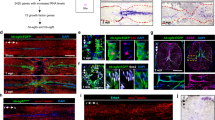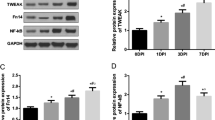Abstract
Spinal cord injury (SCI) is one of the most common devastating injuries, with little possibility of recovery in humans. However, zebrafish efficiently regenerate functional nervous system tissue after SCI. Therefore, the spinal cord transection model of adult zebrafish was applied to explore the role of ATF6 in neuro-recovery. Activating transcription factor 6 (ATF6) is a type-II transmembrane protein in the endoplasmic reticulum (ER). ATF6 target genes could improve ER homeostasis, which contributes to cytoprotection. Herein, we found that the ATF6 level increased at 12 h and 3 days post SCI, and returned to sham levels at 7 days post SCI. ATF6-expressing motor neurons were present in the central canal of the spinal cord and increased at 12 h post SCI. ATF6 morpholino treatment showed that inhibition of ATF6 delayed locomotor recovery and hindered neuron axon regrowth in SCI zebrafish. Furthermore, we investigated the role of both binding immunoglobulin protein (Bip) and C/EBP homologous transcription factor protein (CHOP), the two target genes of ATF6. We found that Bip expression significantly increased in the spinal cord at 7 days after SCI, which served as a pro-survival chaperone. Our results also showed that CHOP expression significantly decreased in the spinal cord at 7 days after SCI, which was identified as a protein involved in apoptosis. Taken together, our data demonstrate that ATF6 may contribute to the functional recovery after SCI in adult zebrafish, via up-regulation of Bip and down-regulation of CHOP to restore the homeostasis of ER.






Similar content being viewed by others
Availability of Data and Materials
The materials used during the present study are available from the corresponding author on reasonable request.
Abbreviations
- SCI:
-
Spinal cord injury
- ATF6:
-
Activating transcription factor 6
- ER:
-
Endoplasmic reticulum
- Bip:
-
Binding immunoglobulin protein
- CHOP:
-
C/EBP homologous transcription factor protein
- UPR:
-
Unfolded protein response
- MO:
-
Morpholino
- hpi:
-
Hours post injury
- dpi:
-
Days post injury
- wpi:
-
Weeks post injury
References
Anna Z, Katarzyna JW, Joanna C, Barczewska M, Joanna W, Wojciech M (2017) Therapeutic potential of olfactory ensheathing cells and mesenchymal stem cells in spinal cord injuries. Stem Cells Int 2017:3978595. https://doi.org/10.1155/2017/3978595
Ayaub EA et al (2016) GRP78 and CHOP modulate macrophage apoptosis and the development of bleomycin-induced pulmonary fibrosis. J Pathol 239:411–425. https://doi.org/10.1002/path.4738
Balch WE, Morimoto RI, Dillin A, Kelly JW (2008) Adapting proteostasis for disease intervention. Science 319:916–919. https://doi.org/10.1126/science.1141448
Becker T, Wullimann MF, Becker CG, Bernhardt RR, Schachner M (1997) Axonal regrowth after spinal cord transection in adult zebrafish. J Comp Neurol 377:577–595
Becker T, Bernhardt RR, Reinhard E, Wullimann MF, Tongiorgi E, Schachner M (1998) Readiness of zebrafish brain neurons to regenerate a spinal axon correlates with differential expression of specific cell recognition molecules. J Neurosci 18:5789–5803
Becker CG, Lieberoth BC, Morellini F, Feldner J, Becker T, Schachner M (2004) L1.1 is involved in spinal cord regeneration in adult zebrafish. J Neurosci 24:7837–7842. https://doi.org/10.1523/JNEUROSCI.2420-04.2004
Belmont PJ et al (2008) Coordination of growth and endoplasmic reticulum stress signaling by regulator of calcineurin 1 (RCAN1), a novel ATF6-inducible gene. J Biol Chem 283:14012–14021. https://doi.org/10.1074/jbc.M709776200
Berridge MJ (2002) The endoplasmic reticulum: a multifunctional signaling organelle. Cell Calcium 32:235–249
Bertolotti A, Zhang Y, Hendershot LM, Harding HP, Ron D (2000) Dynamic interaction of BiP and ER stress transducers in the unfolded-protein response. Nat Cell Biol 2:326–332. https://doi.org/10.1038/35014014
Cao SS, Kaufman RJ (2012) Unfolded protein response. Curr Biol 22:R622–R626. https://doi.org/10.1016/j.cub.2012.07.004
Cornejo VH, Pihan P, Vidal RL, Hetz C (2013) Role of the unfolded protein response in organ physiology: lessons from mouse models. IUBMB Life 65:962–975. https://doi.org/10.1002/iub.1224
Draper BW, Morcos PA, Kimmel CB (2001) Inhibition of zebrafish fgf8 pre-mRNA splicing with morpholino oligos: a quantifiable method for gene knockdown. Genesis 30:154–156. https://doi.org/10.1002/gene.1053
Fang P, Pan HC, Lin SL, Zhang WQ, Rauvala H, Schachner M, Shen YQ (2014) HMGB1 contributes to regeneration after spinal cord injury in adult zebrafish. Mol Neurobiol 49:472–483. https://doi.org/10.1007/s12035-013-8533-4
Goff LA, Bowers J, Schwalm J, Howerton K, Getts RC, Hart RP (2004) Evaluation of sense-strand mRNA amplification by comparative quantitative PCR. BMC Genomics 5:76. https://doi.org/10.1186/1471-2164-5-76
Goldshmit Y, Sztal TE, Jusuf PR, Hall TE, Nguyen-Chi M, Currie PD (2012) Fgf-dependent glial cell bridges facilitate spinal cord regeneration in zebrafish. J Neurosci 32:7477–7492. https://doi.org/10.1523/JNEUROSCI.0758-12.2012
Goldshmit Y, Tang JKKY, Siegel AL, Nguyen PD, Kaslin J, Currie PD, Jusuf PR (2018) Different Fgfs have distinct roles in regulating neurogenesis after spinal cord injury in zebrafish. Neural Dev 13:24. https://doi.org/10.1186/s13064-018-0122-9
Guo Y, Ma L, Cristofanilli M, Hart RP, Hao A, Schachner M (2011) Transcription factor Sox11b is involved in spinal cord regeneration in adult zebrafish. Neuroscience 172:329–341. https://doi.org/10.1016/j.neuroscience.2010.10.026
Hayashi T, Saito A, Okuno S, Ferrand-Drake M, Chan PH (2003) Induction of GRP78 by ischemic preconditioning reduces endoplasmic reticulum stress and prevents delayed neuronal cell death. J Cereb Blood Flow Metab 23:949–961. https://doi.org/10.1097/01.WCB.0000077641.41248.EA
Hetz C, Chevet E, Oakes SA (2015) Proteostasis control by the unfolded protein response. Nat Cell Biol 17:829–838. https://doi.org/10.1038/ncb3184
Kim I, Xu W, Reed JC (2008) Cell death and endoplasmic reticulum stress: disease relevance and therapeutic opportunities. Nat Rev Drug Discov 7:1013–1030. https://doi.org/10.1038/nrd2755
Lee KH, Kim UJ, Park SW, Park YG, Lee BH (2017) Optical imaging of the motor cortex following antidromic activation of the corticospinal tract after spinal cord injury. Front Neurosci 11:166. https://doi.org/10.3389/fnins.2017.00166
Li H, Zhang X, Qi X, Zhu X, Cheng L (2019) Icariin inhibits endoplasmic reticulum stress-induced neuronal apoptosis after spinal cord injury through modulating the PI3K/AKT signaling pathway. Int J Biol Sci 15:277–286. https://doi.org/10.7150/ijbs.30348
Liu D, Yu Y, Schachner M (2014) Ptena, but not Ptenb, reduces regeneration after spinal cord injury in adult zebrafish. Exp Neurol 261:196–205. https://doi.org/10.1016/j.expneurol.2014.06.006
Marchi S, Patergnani S, Pinton P (2014) The endoplasmic reticulum-mitochondria connection: one touch, multiple functions. Biochim Biophys Acta 1837:461–469. https://doi.org/10.1016/j.bbabio.2013.10.015
Ohri SS, Maddie MA, Zhao Y, Qiu MS, Hetman M, Whittemore SR (2011) Attenuating the endoplasmic reticulum stress response improves functional recovery after spinal cord injury. Glia 59:1489–1502. https://doi.org/10.1002/glia.21191
Pan HC, Lin JF, Ma LP, Shen YQ, Schachner M (2013) Major vault protein promotes locomotor recovery and regeneration after spinal cord injury in adult zebrafish. Eur J Neurosci 37:203–211. https://doi.org/10.1111/ejn.12038
Park SW, Ozcan U (2013) Potential for therapeutic manipulation of the UPR in disease. Semin Immunopathol 35:351–373. https://doi.org/10.1007/s00281-013-0370-z
Pei DS, Sun YH, Chen SP, Wang YP, Hu W, Zhu ZY (2007) Zebrafish GAPDH can be used as a reference gene for expression analysis in cross-subfamily cloned embryos. Anal Biochem 363:291–293. https://doi.org/10.1016/j.ab.2006.12.005
Penas C, Guzman MS, Verdu E, Fores J, Navarro X, Casas C (2007) Spinal cord injury induces endoplasmic reticulum stress with different cell-type dependent response. J Neurochem 102:1242–1255. https://doi.org/10.1111/j.1471-4159.2007.04671.x
Penas C, Verdu E, Asensio-Pinilla E, Guzman-Lenis MS, Herrando-Grabulosa M, Navarro X, Casas C (2011) Valproate reduces CHOP levels and preserves oligodendrocytes and axons after spinal cord injury. Neuroscience 178:33–44. https://doi.org/10.1016/j.neuroscience.2011.01.012
Peng SX et al (2017) Semaphorin4D promotes axon regrowth and swimming ability during recovery following zebrafish spinal cord injury. Neuroscience 351:36–46. https://doi.org/10.1016/j.neuroscience.2017.03.030
Reddy RK, Mao C, Baumeister P, Austin RC, Kaufman RJ, Lee AS (2003) Endoplasmic reticulum chaperone protein GRP78 protects cells from apoptosis induced by topoisomerase inhibitors: role of ATP binding site in suppression of caspase-7 activation. J Biol Chem 278:20915–20924. https://doi.org/10.1074/jbc.M212328200
Ren H, Chen X, Tian M, Zhou J, Ouyang H, Zhang Z (2018) Regulation of inflammatory cytokines for spinal cord injury repair through local delivery of therapeutic agents. Adv Sci (Weinh) 5:1800529. https://doi.org/10.1002/advs.201800529
Rowland AA, Voeltz GK (2012) Endoplasmic reticulum-mitochondria contacts: function of the junction. Nat Rev Mol Cell Biol 13:607–625. https://doi.org/10.1038/nrm3440
Sampson TR et al (2016) Gut microbiota regulate motor deficits and neuroinflammation in a model of Parkinson's disease. Cell 167:1469–1480. https://doi.org/10.1016/j.cell.2016.11.018
Shen J, Chen X, Hendershot L, Prywes R (2002) ER stress regulation of ATF6 localization by dissociation of BiP/GRP78 binding and unmasking of Golgi localization signals. Dev Cell 3:99–111. https://doi.org/10.1016/s1534-5807(02)00203-4
Shen J, Snapp EL, Lippincott-Schwartz J, Prywes R (2005) Stable binding of ATF6 to BiP in the endoplasmic reticulum stress response. Mol Cell Biol 25:921–932. https://doi.org/10.1128/MCB.25.3.921-932.2005
Singh A, Tetreault L, Kalsi-Ryan S, Nouri A, Fehlings MG (2014) Global prevalence and incidence of traumatic spinal cord injury. Clin Epidemiol 6:309–331. https://doi.org/10.2147/CLEP.S68889
Song G, Li Q, Long Y, Hackett PB, Cui Z (2012) Effective expression-independent gene trapping and mutagenesis mediated by sleeping beauty transposon journal of genetics and genomics. Yi Chuan Xue Bao 39:503–520. https://doi.org/10.1016/j.jgg.2012.05.010
Tajiri S et al (2004) Ischemia-induced neuronal cell death is mediated by the endoplasmic reticulum stress pathway involving CHOP. Cell Death Differ 11:403–415. https://doi.org/10.1038/sj.cdd.4401365
Takeda A, Goris RC, Funakoshi K (2007) Regeneration of descending projections to the spinal motor neurons after spinal hemisection in the goldfish. Brain Res 1155:17–23. https://doi.org/10.1016/j.brainres.2007.04.020
Tsarouchas TM et al (2018) Dynamic control of proinflammatory cytokines Il-1beta and Tnf-alpha by macrophages in zebrafish spinal cord regeneration. Nat Commun 9:4670. https://doi.org/10.1038/s41467-018-07036-w
van Huizen R, Martindale JL, Gorospe M, Holbrook NJ (2003) P58IPK, a novel endoplasmic reticulum stress-inducible protein and potential negative regulator of eIF2alpha signaling. J Biol Chem 278:15558–15564. https://doi.org/10.1074/jbc.M212074200
Wang XZ et al (1996) Signals from the stressed endoplasmic reticulum induce C/EBP-homologous protein (CHOP/GADD153). Mol Cell Biol 16:4273–4280
Wang J et al (2018) Local delivery of beta-Elemene improves locomotor functional recovery by alleviating endoplasmic reticulum stress and reducing neuronal apoptosis in rats with spinal cord injury. Cell Physiol Biochem 49:595–609. https://doi.org/10.1159/000492996
Wu J et al (2007) ATF6alpha optimizes long-term endoplasmic reticulum function to protect cells from chronic stress. Dev Cell 13:351–364. https://doi.org/10.1016/j.devcel.2007.07.005
Yu Y, Schachner M (2013) Syntenin-a promotes spinal cord regeneration following injury in adult zebrafish. Eur J Neurosci 38:2280–2289. https://doi.org/10.1111/ejn.12222
Yu YM, Cristofanilli M, Valiveti A, Ma L, Yoo M, Morellini F, Schachner M (2011) The extracellular matrix glycoprotein tenascin-C promotes locomotor recovery after spinal cord injury in adult zebrafish. Neuroscience 183:238–250. https://doi.org/10.1016/j.neuroscience.2011.03.043
Zhang HY et al (2015) Endoplasmic reticulum stress: relevance and therapeutics in central nervous system diseases. Mol Neurobiol 51:1343–1352. https://doi.org/10.1007/s12035-014-8813-7
Zinszner H et al (1998) CHOP is implicated in programmed cell death in response to impaired function of the endoplasmic reticulum. Genes Dev 12:982–995. https://doi.org/10.1101/gad.12.7.982
Acknowledgements
We sincerely thank Professor Stanley Li Lin for his careful revision of the manuscript, both language and science issues.
Funding
This study was funded by the National Natural Science Foundation of China (81771384, 81760235), and the National First-class Discipline Program of Food Science and Technology (JUFSTR20180101).
Author information
Authors and Affiliations
Contributions
Zhe Ji performed major experiments, Zhi-Lan Zhou contributed to manuscript preparation and surgeries for the spinal cord injury model, Qin Hao performed in situ hybridization analysis, Lin Zhao performed real-time quantitative PCR analysis. Chun Cui helped to process data, Shu-Bing Huang performed swim tracking, Yan-Ling Yang and Yan-Qin Shen conceived the study.
Ethics approval and consent to participate.
Corresponding authors
Ethics declarations
Competing Interests
The authors declare that they have no conflict of interest.
Additional information
Publisher’s Note
Springer Nature remains neutral with regard to jurisdictional claims in published maps and institutional affiliations.
Rights and permissions
About this article
Cite this article
Ji, Z., Zhou, ZL., Hao, Q. et al. Activating Transcription Factor 6 Contributes to Functional Recovery After Spinal Cord Injury in Adult Zebrafish. J Mol Neurosci 71, 734–745 (2021). https://doi.org/10.1007/s12031-020-01691-9
Received:
Accepted:
Published:
Issue Date:
DOI: https://doi.org/10.1007/s12031-020-01691-9




